May 14th, 2015
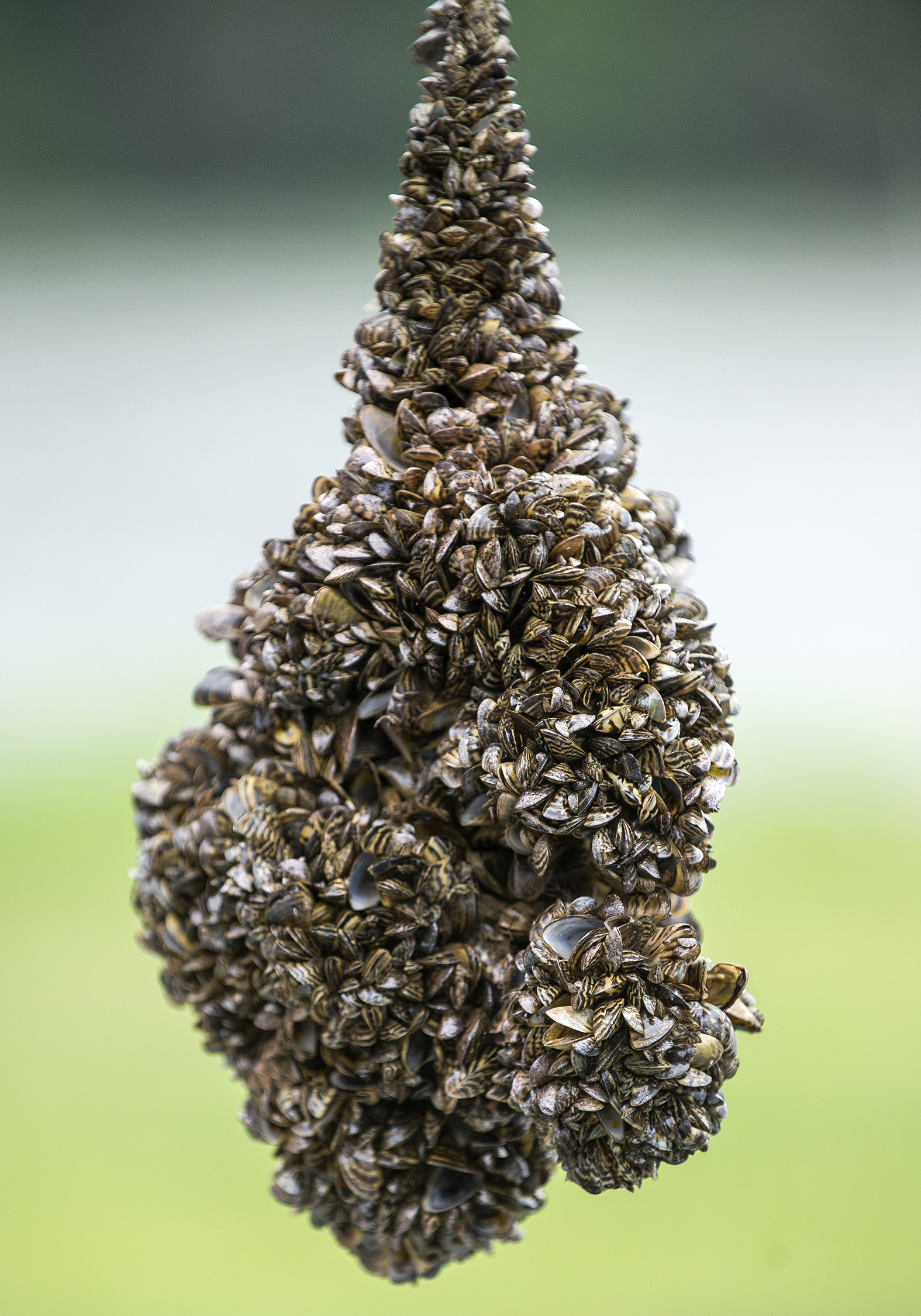
Zebra mussels
This is Passport to Texas
In September 2014, when City of Waco employees found zebra mussels near a boat ramp in Lake Waco, Texas Parks and Wildlife, the City of Waco, and Texas Army Corps of Engineers moved quickly to stop this non-native aquatic invasive in its tracks.
06-The City of Waco ordered up tarps, they hired commercial divers, set the plan, and last fall we put ’em all in place.
Brian Van Zee, Inland Fisheries Regional Director, says there wasn’t time to obtain permits for chemical treatments, so divers and staff positioned the eight thick, rubber tarps on the lake bottom over the infested area to block sunlight and oxygen below.
15- We just recently pulled those tarps from lake Waco, and it was really looking very good; we could tell by the condition of the tarps– underneath them–that we had reached anoxic conditions. You could smell the hydrogen sulfide smell and these black conditions you typically see when you have anoxic conditions.
Although divers found two live zebra mussels on rocks they brought up, Van Zee is optimistic.
14-Maybe we knocked back the number of zebra mussels that were in that area, far enough to where they cannot create a viable, reproducing population. We don’t know if that’s the case or not. We really won’t know probably until this spring or summer, actually; maybe even next fall.
Until then, all partners will continue to monitor the lake and enforce the clean, drain and dry law for all boaters. Learn more on the TPW website.
The Wildlife and Sport Fish Restoration program supports our series. Learn about combating zebra mussels and other aquatic invasives at texasinvasives.org.
For Texas Parks and Wildlife…I’m Cecilia Nasti.
Posted in Aquatic invasives, Boating, Conservation, Education, Fishing, Freshwater, Habitat, Texas Invasives, Wildlife and Sport Fish Restoration Program, Zebra mussels | Comments Off on Beating Down Zebra Mussels in Lake Waco
May 13th, 2015
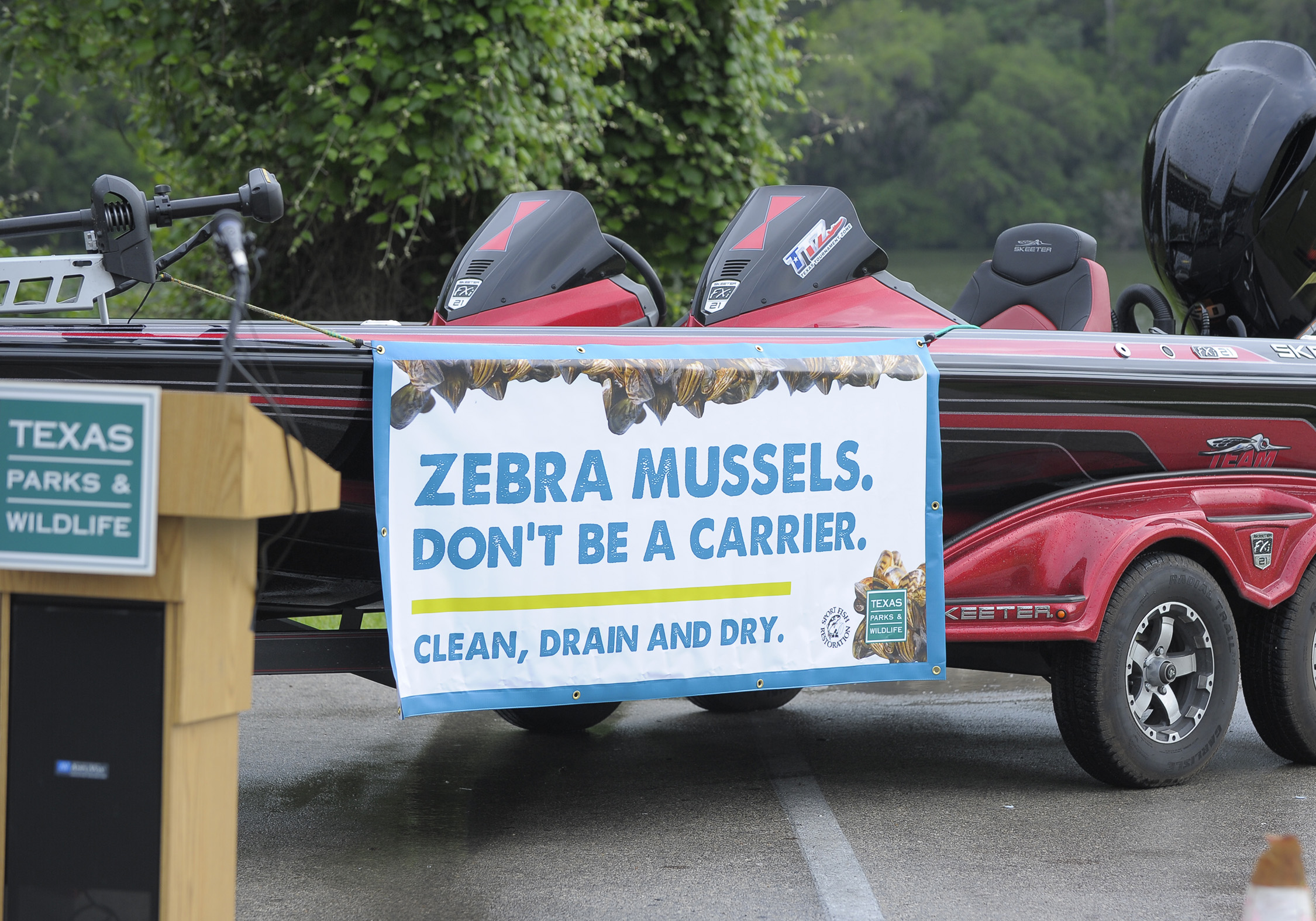
Clean, drain and dry your boats to prevent the spread of zebra mussels.
This is Passport to Texas
Before zebra mussels appeared in Lake Waco, Texas Parks and Wildlife, the City of Waco and the Army Corps of Engineers worked on ways to prevent an infestation, which involved close monitoring of arriving vessels.
06–They city hired summer interns to conduct boater education and boater surveys and inspections, in an effort to try and prevent the introduction [of zebra mussels] to Lake Waco.
Brian Van Zee, Texas Parks and Wildlife Inland Fisheries Regional Director, says despite their best efforts, in the summer of 2014, a vessel previously in zebra mussel infested Lake Belton evaded their scrutiny and launched in Lake Waco. In September, City of Waco employees found zebra mussels near the boat ramp. And everyone mobilized.
27– [We thought] if we can act quickly, before the water temperature begins cooling down in the fall again, we might be able to get on top of these things. And, we had heard and seen studies where they had used these big, heavy, thick pond liners and covered an area; and you can suffocate them [zebra mussels]. So, we knew that we could get approval from the Corps of Engineers to install those and get that done pretty quickly, So, the City of Waco ordered up the tarps, they hired commercial divers, set the plan, and last fall we put ’em all in place.
Brian Van Zee shares the results of their efforts tomorrow.
The Wildlife and Sport Fish Restoration program supports our series. Get more information about zebra mussels at texasinvasives.org.
For Texas Parks and Wildlife…I’m Cecilia Nasti.
Posted in Boating, Fishing, Freshwater, Habitat, Research, Texas Invasives, Zebra mussels | Comments Off on Combating Zebra Mussels in Lake Waco
May 12th, 2015
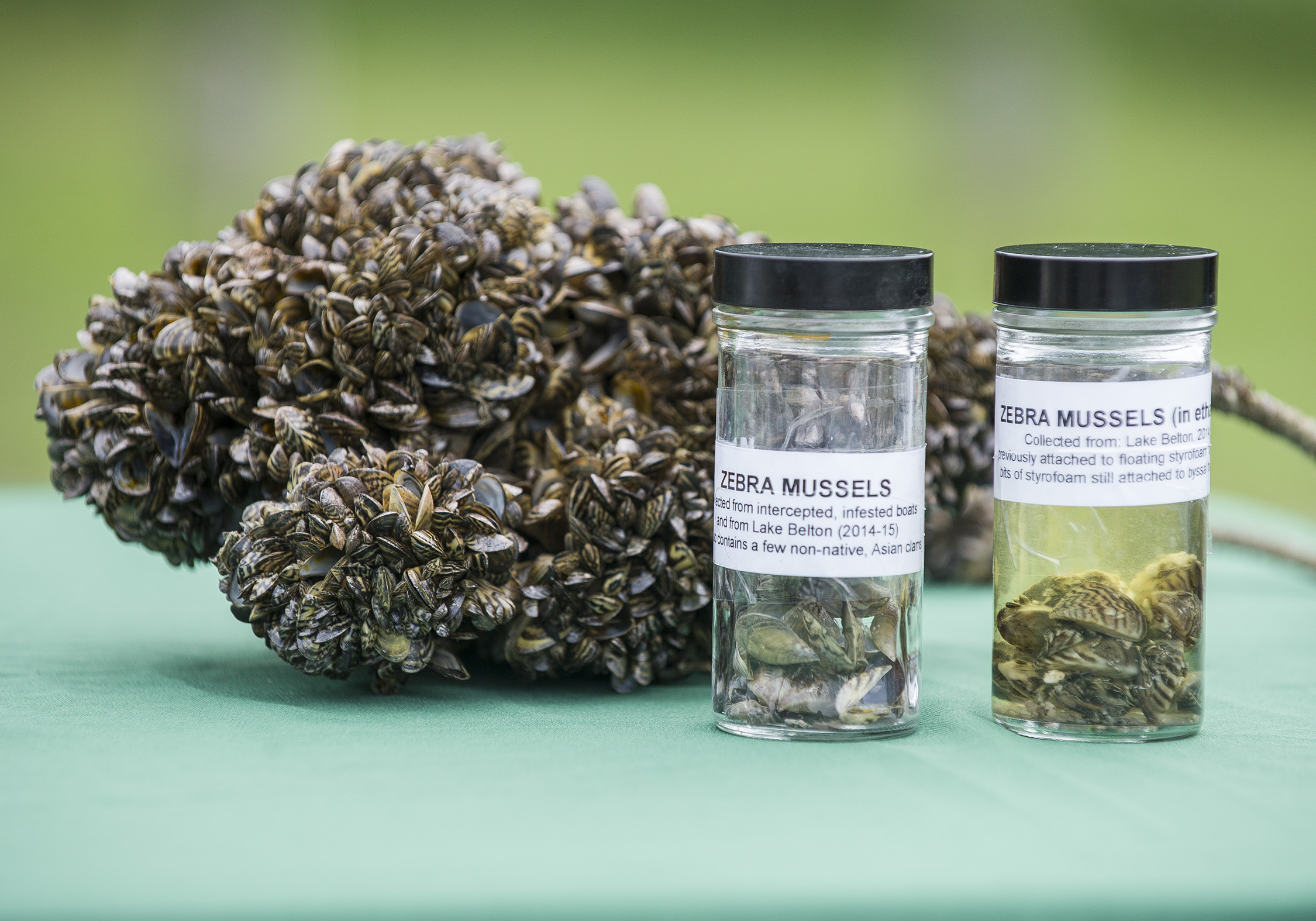
Zebra Mussels
This is Passport to Texas
Non-native zebra mussels pose potential ecological and economic damage wherever there’s an infestation. In September 2014, they showed up in Lake Waco.
06-Unfortunately there was a vessel that was launched on Lake Waco last summer; it had come from Lake Belton.
Brian Van Zee, Texas Parks and Wildlife Inland Fisheries Regional Director, says Lake Belton has an established population of zebra mussels; they hitched a ride to Lake Waco on the vessel in question.
15- It was heavily infested with those individuals when they left Lake Belton. They did not inspect it; they did not clean it. So, they launched on Lake Waco and introduced these mussels to the lake.
The zebra mussel larvae are microscopic, which is why it is imperative boaters clean, drain and dry their vessels when going from one water body to the next.
24-Texas Parks and Wildlife department enacted the law last year requiring boaters–anytime they leave or approach a freshwater lake or river system in the state–their boats have to be dry. And that’s all aimed at preventing the spread of these microscopic organisms. So, take those three simple steps of clean, drain, dry; it doesn’t take long. It’s very simple to do. It’s better for your boat in terms of maintenance, anyway; so go ahead and do it.
What Texas Parks and Wildlife, the City of Waco and Army Corps of Engineers is doing to combat zebra mussels in Lake Waco–that’s tomorrow. Learn more about zebra mussels at www.texasinvasives.org.
The Sport Fish Restoration program supports our series.
For Texas Parks and Wildlife–I’m Cecilia Nasti.
Posted in Conservation, Education, Habitat, Texas Invasives, Wildlife and Sport Fish Restoration Program, Zebra mussels | Comments Off on Zebra Mussels Come to Lake Waco
May 11th, 2015
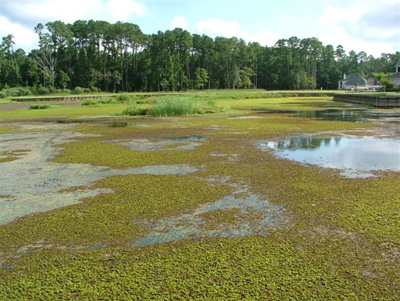
Giant Salvinia overtaking Lake Conroe
This is Passport to Texas
Giant Salvinia…tilapia…zebra mussels… are just three of the many non-native, invasive aquatic species threatening Texas rivers and lakes.
11-As a whole, anytime you get an invasive species into the state–whether it be a new one or one we are currently dealing with–they certainly cause a lot of economic as well as environmental negative impact.
Brian Van Zee is a TPW Inland Fisheries Regional Director.
15- When an invasive species gets introduced into a new system, they typically have very few predators or natural control mechanisms in place. So, they are able to take over and dominate those systems; that just creates a lot of problems for a lot of our native species.
Giant salvinia quickly creates huge, thick mats of vegetation on lakes, reducing light penetration that results in oxygen depletion; tilapia outcompete native fishes for food, thus threatening their populations; and zebra mussels adhere to municipal water intake pipes,
blocking water flow, and costing cities millions of dollars in repairs and maintenance.
05-We have seven lakes in the state that have confirmed zebra mussels in them.
Brian Van Zee returns tomorrow to talk about the latest zebra mussel infestation and how it happened. Learn more about aquatic invasives at www.texasinvasives.org.
The Sport Fish Restoration program supports our series and works to increase fishing and boating opportunities in Texas.
For Texas Parks and Wildlife…I’m Cecilia Nasti.
Posted in Aquatic invasives, Giant Salvinia, Habitat, Texas Invasives, Tilapia, Zebra mussels | Comments Off on Aquatic Invasives
May 8th, 2015
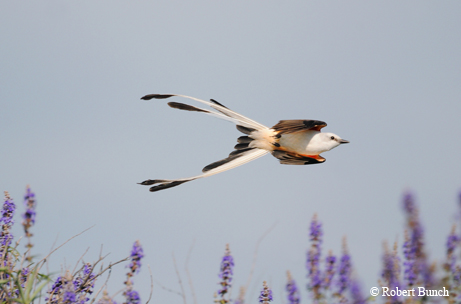
Scissor-tailed flycatcher; photo by Robert Bunch
This is Passport to Texas
No parent wants to openly admit they have a favorite child, just as ornithologist, Cliff Shackelford, hesitated to reveal his picks for Texas’ 12 most beautiful birds in an article for Texas Parks and Wildlife magazine’s May issue. He called it a 639 way tie.
07—The 639 is how many birds are documented in Texas; and to me, they all have some beauty in one form or another.
Cliff said his picks were not the “obvious choices.”
22— I kept out—purposefully—birds that most people would agree are super gorgeous and super obvious; things like: Northern Cardinal, Cedar Waxwing, Painted Bunting… You can’t be a ‘shoe in’. And I think some of these birds are considers a shoe in, but [sigh] too much bling, too much gaudiness, like in a painted bunting—to me—kept it off the list.
In fact, the color of a bird’s plumage had less to do with it making the list of beautiful birds than did its behavior.
20— And I pointed that out in the article. Some birds maybe didn’t have the jazziest colors, but they excelled in other ways. Like, the Swallow-tailed Kite is a very simple black and white
bird, but the Swallow-tailed Kite makes up for it with its graceful flight—very effortlessly soaring against a blue sky—is just, to me, breathtaking and beautiful.
Which birds made Cliff Shackelford’s list for most beautiful? Find out in the May issue of TPW magazine. What’s on your list of beautiful Texas birds? Tell us at passporttotexas.org.
For Texas Parks and Wildlife…I’m Cecilia Nasti.
Posted in Birding, TPW Mag | Comments Off on Texas’ 12 Most Beautiful Birds







 Passport to Texas is a
Passport to Texas is a  Passport to Texas is made available by:
Passport to Texas is made available by: